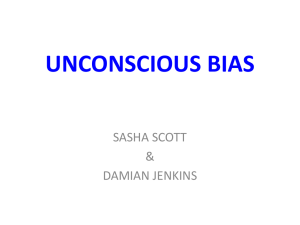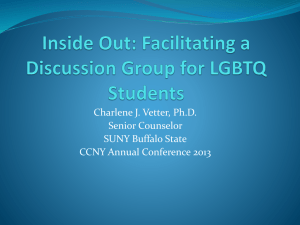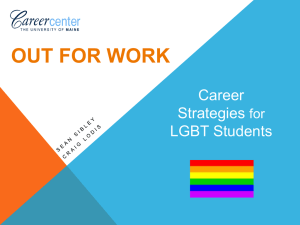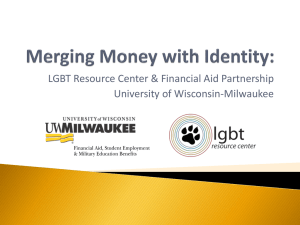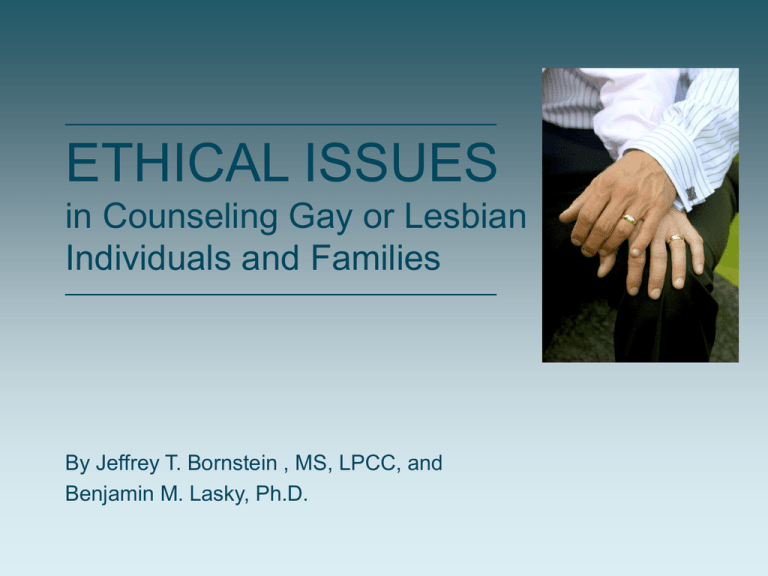
ETHICAL ISSUES
in Counseling Gay or Lesbian
Individuals and Families
By Jeffrey T. Bornstein , MS, LPCC, and
Benjamin M. Lasky, Ph.D.
Declaration
• We hereby declare that we have no financial or proprietary
interests in giving this presentation.
• Some of the matters here are aspirational while others are
mandated by State and Federal Laws.
• Each attendant should adhere to rules and regulations provided
by their licensing boards.
Goals and Objectives
I. Explain how Heterosexism and
Homophobia account for
Discrimination
II. Impact of Staying Closeted or
Coming Out
III.Cass Stage Model of Developing
Gay Identity
IV.Obstacles to Developing Gay
Identity
V. Models to Treat LGBT Clients
Heterosexism, Homophobia and
Discrimination
• LGBT individuals live in a predominantly heterosexual
environment marked by HOMOPHOBIA (the fear and hatred of
gay and lesbian people) and
• HETEROSEXISM (the perceived superiority of heterosexuality
over nonheterosexuality).
• These attitudes can translate into destructive and violent
actions toward the gay or lesbian individual.
Types of Discrimination
Individual Discrimination
• GLBT individuals are subjected to verbal and physical attacks.
For example, one study of Gays and Lesbians age 15-21
found that 80% had experienced verbal attacks, 44% had
been threatened with violence, 33% had objects thrown at
them, and 31% had been chased or followed, and 17% had
been physically assaulted.
• LGBT teens are 5 times more likely to miss school after being
bullied due to sexual orientation because they feel unsafe.
• Adult LGBT individuals also face discrimination. One study
found that 42% of LGBT adults felt that they experience
discrimination due to sexual orientation on a day-to-day basis
Types of Discrimination
Institutional Discrimination – the policies and laws
• During the cold war, the federal government enacted policies
and procedures to effectively ban LGBT individuals from
gaining employment in civil service and intelligence agencies.
LGBT individuals would not be hired because it was presumed
they posed a security risk. The premise was that enemy
forces could blackmail these individuals to divulge secrets.
• This discrimination carried into the private sector and the
LGBT population was effectively barred from 20% of the
nation’s jobs.
Types of Discrimination
Institutional Discrimination
• 1993 a Michigan Court of Appeals held that sexual orientation
was not protected, so, workplace discrimination based on a
person’s sexual orientation was not prohibited.
• In 29 states, it is fair to be fired for being LGBT or denied
promotions, in 38 states, you can be fired for being
transgender.
• If they are in a career that is homophobic or heterosexist,
they may decide they need a new career. Wherever they
work, they should become aware of what protections exist
under the law.
- Many states currently have proposed amendments to ban same sex marriage (e.g.,
Prop 8 passed in California in 2008 election).
Types of Discrimination
• Cultural Discrimination – Most present in religions of society.
Very few religions are accepting of homosexuality, so, a place
where one usually turns to for support often treats the LGBT
individual as if he/she is not worthy or evil.
• Families of origin can struggle to tolerate and accept that they
have an LGBT family member at varying degrees.
• Church’s that support gay marriage include progressive
Christian denominations (eg., Episcopalian, Evangelical
Lutheran) conservative and reform Judaism, Liberal Hinduism,
Progressive Muslims, and Native American Religions
• Lesbians and Gays often choose to lead closeted lives to
avoid these types of discriminations
Staying Closeted or Coming Out
• If an LGBT individual decides to
stay closeted, this can lead to
internal conflict between his/her
natural homosexual urges and
his/her desire to fit into the
mainstream. This can lead to
mental and physical issues such as
Major Depression, Anxiety, Eating
Disorders, and Substance Abuse,
and Gastrointestinal Discomfort.
• This can also lead to guilt and
shame over having to keep a secret
Deciding To Come Out
• If the person comes out, he or
she must face the prevailing
heterosexist and homophobic
attitudes associated with this
behavior. This hatred often
leads to Internalized
Homophobia (self-hate).
• Self-hate interferes with
developing healthy, long term
relationships, intimacy issues
and other mental health issues
Deciding To Come Out
• The out individual also may face issues with his or her family
of origin. Even in families that accept, there are no rituals
(e.g., weddings, birth of grandchildren, etc.) in mainstream
society that bond gay and lesbian children to their family.
• LGBT culture also does not have rituals that include
heterosexual people with the exception of P-Flag (Parents
and Friends of Lesbian and Gays).
• These are issues counselors must be aware of when seeing
LGBT clients.
Stresses of Coming Out
• Coming out is a lifetime process and
not a one time event.
• Out individuals must develop their
gay identity and come to terms with
individual, institutional, and cultural
discrimination. The gay or lesbian
individual has to shift from the
socially accepted heterosexual
identity to the socially denigrated
nonheterosexual LGBT identity.
• LGBT individuals may have difficulty
forming relationships with other
LGBTs due to lack of opportunities in
their environment.
Cass Stage Model of LGBT Identity
Development
• A stage development model that
describes the identity
development of LGBT individuals.
This helps therapists predict
some of the developmental
issues that LGBT individuals
have to face.
• The Cass Model was developed
in 1979 by Vivian Cass and is a 6
stage model. The model does
not account for race, religion,
culture, gender, and ability.
Cass Stage Model of LGBT Identity
Development
Stage 1 Identity Confusion
• Person’s first awareness of gay or lesbian thoughts, feelings,
and attractions (‘could I be gay?’). The person usually feels
confused and has turmoil. In this stage, they may deny their
homosexuality (e.g, ‘just experimentation,’ ‘it was the alcohol’).
• Oftentimes, they keep emotional involvement separated from
sexual involvement.
• During this stage, the person may need permission from the
therapist that it is OK to explore sexual identity.
Cass Stage Model of LGBT Identity
Development
Stage 2 Identity Comparison
• Person accepts that they might be LBGT and becomes aware
that this has wide implications. Often in this stage, the LGBT
person feels alienated which can lead to isolation.
• At this stage, they may compartmentalize their own sexuality,
but maintain a heterosexual identity (e.g., my gay feelings are
only temporary, I am just in love with this one particular
man/woman).
• The therapist must discuss the implications of loss of
heterosexual life expectations, provide community resources,
and help them overcome isolation.
Cass Stage Model of LGBT Identity
Development
Stage 3 Identity Tolerance
• The individual acknowledges LGBT identity and seeks out
other gay and lesbians to combat isolation. They start to
realize that they are not the only one going through this.
Internalized homophobia is often seen during this stage.
• They are more willing to understand that being LGBT is
permanent and to look for others to end isolation. They may
try out a variety of stereotypical roles.
• The therapist needs to provide support in exploring selfshame feelings derived from internalized homophobia and
heterosexism and make sure they are aware of the community
resources available to them.
Cass Stage Model of LGBT Identity
Development
Stage 4 Identity Acceptance
• The individual feels positive about being LGBT and increases
contact with LGBT culture. Oftentimes, individuals in this
stage have less and less contact with the heterosexual
community. They usually are more comfortable coming out
and being seen with LGBT individuals and groups. They are
more comfortable ‘coming out’ and do so more frequently.
• The therapist continues to help LGBT people deal with
internalized homophobia and helps them better understand
when it is appropriate to ‘come out.’
Cass Stage Model of LGBT Identity
Development
Stage 5 Identity Pride
• LGBT individual compartmentalizes the world into
heterosexuals and homosexuals and has an ‘us vs. them’
political/social viewpoint
• At this stage, therapists need to help them explore their anger
and issues of heterosexism. For example, an LGBT person in
this stage may need to be told to have patience with family
members, as they have just learned that this person came out,
while the person who came out had been working on the issue
their entire lives.
Cass Stage Model of LGBT Identity
Development
Stage 6 Identity Synthesis
• The individual integrates sexual orientation identity with all
aspects of self and sexual orientation becomes only one
aspect of self rather than entire identity.
• At this stage, therapists need to continue to be mindful that
LGBT individuals will always face heterosexism and
homophobia and there is always a chance they could regress
to an earlier stage.
D’Augelli’s Model of Lesbian,Gay,
Bisexual Development (1994)
• A lifespan model: 3 interrelated Variables interact for identity
formation:
• Personal Actions, and Subjectivities: An individual’s selfconcept in relation to his/her sexual behaviors, feelings, and
thoughts
• Interactive Intimacies: an individual’s inner circle’s response
and interactions with partners
• Sociohistorical Connections: Society’s view, demographics of
residence, and beliefs
D’Augelli Model
• Exiting Heterosexual Identity: Acknowledging that feelings
are not heterosexual in nature
• Developing a Personal Lesbian/Gay/Bisexual Identity Status:
An individual’s personal definition of being homosexual
• Developing a Social Lesbian/Gay/Bisexual Identity: An
individual’s homosexual identity as it pertains to peer groups
and social norms
D’Augelli Model
• Becoming a Lesbian/Gay/Bisexual Offspring: An individual’s
attempt to share his/her homosexual identity with parents and
its consequence
• Developing a Lesbian/Gay/Bisexual Intimacy Status: The
journey to find a meaningful, intimate relationship
• Entering a Lesbian/Gay/Bisexual Community: An individual’s
recognition of injustices and triumphs and joining the
community
Challenges to Developing a Gay
Identity
• They must shift from socially
accepted heterosexual
identity to socially denigrated
LGBT identity.
• This shift signifies that they
will now directly have to deal
with individual, institutional,
and cultural discrimination
Challenges to Developing a Gay
Identity
• LGBT individuals have realistic concerns that coming out will
lead to rejection, estrangement, and mistreatment from their
family of origin
• Family of Origin – In one study, 50% of mothers of LGBT
college sons initially reacted with disbelief or denial when
finding out their sons were gay or bisexual. 50% of fathers
reacted with silence or disbelief. 18% of parents reacted with
intolerance, attempts to convert them to heterosexuality, and
verbal threats to cut them off financially.
• Most parents eventually come to accept or tolerate their
child’s sexual orientation, but the above reactions can delay
the ‘coming out’ process.
Challenges of Developing a Gay Identity
• Coming out can lead to satisfaction, renegotiation of family
ties, empowerment, and integration of gay and straight lives.
• Coming out is the hallmark of gay/lesbian identity
development.
• Therapists should note that many of the mental health issues
seen during the coming out process often mimic
psychopathology (e.g., eating disorders, substance abuse,
affective disorders, depression) and should be interpreted in
the developmental context rather than a primary diagnosis.
• Therapists should be aware that adolescents who recently
came out are at heightened risk for suicide attempts
Developmental Issues
• According to Erik Erikson’s
Developmental Stage Model,
individuals face developmental
tasks or conflicts at various
stages of their life. If the person
resolves the conflict, they
develop in a healthy manner. If
they do not, they may develop
issues that are rooted in
unresolved conflict.
• In Erikson’s fifth stage, LGBT
individuals can have greater
difficulty resolving Identity vs.
Role Confusion during
adolescence when their
heterosexual peers are expected
to accomplish this task.
Developmental Issues
• LGBT individuals have a
more difficult time
resolving Identity vs. Role
Confusion due to a lack of
role models as well as the
repression of their true
sexual identity.
• One manifestation of
successful resolution of
Identity vs. Role
Confusion for the LGBT
person is ‘coming out.’
Models to Treat LGBT Clients
Multicultural model
• Therapists must be aware their client is not part of the
mainstream and understand how living in a homophobic and
heterosexist culture impacts their client.
• Therapists must be aware how LGBT individuals may have a
negative view of their profession. For example, until 1973, the
APA considered homosexuality a disorder. Now, the APA
(2002) and ACA (1995) include sexual orientation and gender
identity in their code of ethics and mandate that diversity of
this type be respected.
Multicultural Model –
Therapist Errors
• Failing to recognize that
‘coming out’ is a major event by
glossing over it.
• Assuming an opposite gender
when discussing a client’s
romantic relationship
(heterosexism).
• Having assessment forms that
have non-inclusive language.
• Gay and lesbians have
communicated they feel
negative when such things
occur in the counseling session
which hurts rapport.
Multicultural Model - Suggestions
• Ask nonjudgmental questions about sexual orientation.
• Have inclusive language in assessment forms.
• Sex/Gender: M, F, Intersex, Transgendered.
• Relationship/Marital Status: Single, Married, Living Together,
Partnered, Divorced).
• Early self-disclosure from therapists who are homosexual.
• Have textbooks of homosexuality on bookshelves.
• These types of actions help build relationships.
Multicultural Model
Questions for a straight therapist to ask themselves:
• Are my family values inclusive of LBGT individuals and their
families?
• Is a healthy and happy life compatible with being gay or
lesbian?
• Can I let the gay/lesbian couple take the lead in determining
whether a relationship is workable and healthy?
• Am I ok with gays/lesbians having families and being parents?
• Would I be willing to be the client of a gay/lesbian therapist?
Multicultural Model
• Straight therapists must be ready for their client to express
rage and anger they perceive as injustices from the
mainstream heterosexist, homophobic world without taking it
personally and acting defensively
• Help their client work through the pros and cons of what
coming out will mean at work, with family or origin and all of
their environments
Rational Emotive Behavior Therapy
• Unlike the Multicultural Model
which posits that LGBT
individuals experience
psychological issues due to
their environment, REBT
therapists posit that LGBT
individuals cause their own
problems by their reactions to
the environment. LGBT
individuals who learn REBT
redefine how they feel about
themselves and how they
react to their environment.
Rational Emotive Behavior Therapy
Core Aspect of REBT Therapy
• A (activating event) influences B (beliefs about event), which
results in C (consequences). In reality, the person’s belief
system causes the consequences. With this approach,
patients learn to replace their faulty beliefs with ones that
lead to positive consequences.
Psychoanalysis
• The therapist tries to make clients’ unconscious thoughts and
motivations conscious. Once aware of these unconscious thoughts,
they can modify these thoughts for a healthy and significant change
in their personality.
• LGBT individuals are hesitant to engage in psychoanalysis due to
perception that the theory condemns homosexuality or treats it as a
disorder.
• Freud did consider the development of homosexuality was due to
arrested development of the phallic stage.
• At the same time, Freud did not treat homosexuality as a disorder
and believed psychoanalysis could effectively be used to treat LGBT
individuals the same way he would treat heterosexuals.
Conversion Therapy
What should a therapist do if a
potential client comes to therapy to
become free of homosexual thoughts
and feelings?
• Explain informed consent and make
sure client understands the
information shared is confidential.
• Explain that there are no
substantiated claims that therapy
can convert sexual orientation.
• Discuss alternatives to conversion
therapy.
• Be aware that client may not be
comfortable discussing their
homosexual feelings and may not
allow exploration.
Conversion Therapy
• If patient still wants Conversion Therapy, the therapist can
provide this therapy if they feel they have a good
understanding of the patient’s religion and moral value system
and accept that their mode of therapy has effectiveness with a
wide range of disorders.
• Gay therapists should reveal their sexuality as this could have
an impact if the client wants to move forward.
Kinsey Heterosexual-Homosexual
Rating Scale
The 7 Point Scale
• 0 – Heterosexual 100%
• 1 – Predominantly heterosexual, only
incidentally homosexual
• 2 – Predominantly Heterosexual, but more
than incidentally homosexual
• 3 – 50% heterosexual, 50% homosexual
• 4 – Predominantly homosexual, but more
than incidentally heterosexual
• 5 – Predominantly homosexual, only
incidentally heterosexual
• 6 – Exclusively homosexual
•
In a therapeutic setting, this could be used to help alleviate concerns of someone
who identifies as heterosexual but has homosexual thoughts, or someone who
identifies as homosexual but is upset over heterosexual thoughts they have.
Kinsey Heterosexual-Homosexual
Rating Scale
• This rating scale was developed in 1948 to account for their
research findings that showed people do not fit into neat and
exclusive heterosexual or homosexual categories.
• Kinsey stated, “males do not represent 2 discrete populations,
heterosexual and homosexual. The world is not to be divided
into sheep and goats, …The living world is a continuum in
each and every one of its aspects.”
• In their book, Sexual Behavior of the Human Female, the
authors noted that , “it is characteristic of the human mind that
tries to dichotimize in its classification of phenomena….many
persons do not want to believe that there are gradations in
these matters from one to the other extreme.”
Community Resources
• Los Angeles Gay and Lesbian
Center Los Angeles, CA 900286213. Tel: 323-993-7400,
laglc.convio.net.



